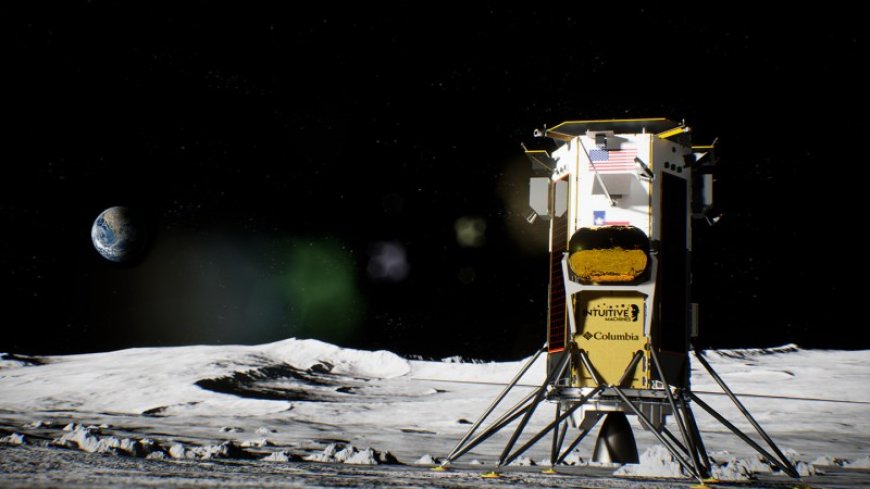The first U.S. lunar lander since 1972 touches down on the moon
50-plus years after Apollo 17, a private U.S. company hauling NASA payloads landed on the moon. Success will help pave the way for humans to return.

After a nail-biting descent, the United States took one small step back to the surface of the moon.
A spindly robotic lander named Odysseus — designed and built by a private U.S. company — touched down near the moon’s south pole at about 6:23 p.m. Eastern time. The probe, which is carrying six NASA payloads plus a few other odds and ends, is the first U.S. vehicle to perform a controlled descent to the lunar soil since Apollo 17 landed in 1972.
“I know this was a nail-biter but we are on the surface and we are transmitting and welcome to the moon,” Intuitive Machines CEO Steve Altemus said during a live NASA broadcast. “Houston, Odysseus has found its new home.”
Houston-based private company Intuitive Machines is overseeing the mission, which launched from Kennedy Space Center in Florida on February 15. Odysseus’ destination was a flat region near the Malapert A crater, about 300 kilometers from the moon’s south pole. The spot is near one of several potential landing sites for future NASA astronauts.
Engineers had to deal with several unexpected problems during the landing attempt, most prominently the fact that the spacecraft’s laser range finder, part of its autonomous landing system, stopped functioning. Mission planners decided to stay in orbit for an extra two hours and then were able to use two backup lasers that were part of a NASA payload to complete the descent.
“What we can confirm without a doubt is that our equipment is on the moon and we are transmitting,” mission director Tim Crain, chief technology officer of Intuitive Machines said shortly after touchdown. Communication with the spacecraft was patchy, and it was unclear immediately what shape it was in. But after a couple of hours, flight controllers confirmed that Odysseus was upright and starting to send data.
Odysseus, which stands about 4 meters tall and 1.5 meters wide, is hauling a half dozen NASA instruments designed to demonstrate equipment for future landings and better understand the environment near the south pole in service of planned astronaut missions. The payloads will test precision landing technologies, try out a new way of knowing how much lander fuel is left, investigate the radio environment near the moon’s surface, and plop a set of retroreflectors on the ground that will serve as a permanent location marker.
Though NASA is the company’s main customer, the space agency’s instruments aren’t the only passengers. Payloads from several private companies and groups are along for the ride as well. They include a camera designed by students and faculty at Embry-Riddle Aeronautical University in Daytona Beach, Fla. The camera was to be jettisoned from the lander about 30 meters above the surface to capture the first images of a lunar touchdown from outside the incoming spacecraft. And Odysseus is delivering the first art installation on the moon: A cube of 125 miniature sculptures that commemorate human curiosity.
“We couldn’t be more thrilled,” says Steve Durst, director of the International Lunar Observatory, a private company based in Kamuela, Hawaii, that sent a small telescope as one of the payloads on Odysseus. The telescope, named ILO-X, expects to take scientific images of the Milky Way from the lunar surface that will be used by researchers to study our galaxy.
The Intuitive Machines venture is part of NASA’s Commercial Lunar Payload Services program, wherein the agency hires companies to scout the moon in support of the Artemis lunar program (SN: 11/16/22). Under Artemis, NASA aims to reestablish a human presence on the moon, with the first crewed landing no earlier than late 2026.
It’s been more than 50 years since astronaut Eugene Cernan left the last U.S. footprints on the moon. In recent years, a string of robotic landing attempts have been made by private companies and countries alike, though most failed (SN: 8/23/23). The landing by Odysseus today has moved the United States closer to its next giant leap in space exploration.
“Today, for the first time in more than a half century, the U.S. has returned to the moon,” said NASA administrator Bill Nelson during the NASA broadcast. “Today is a day that shows the power and promise of NASA’s commercial partnerships. Congratulations to everyone involved in this great and daring quest.”
What's Your Reaction?



























































